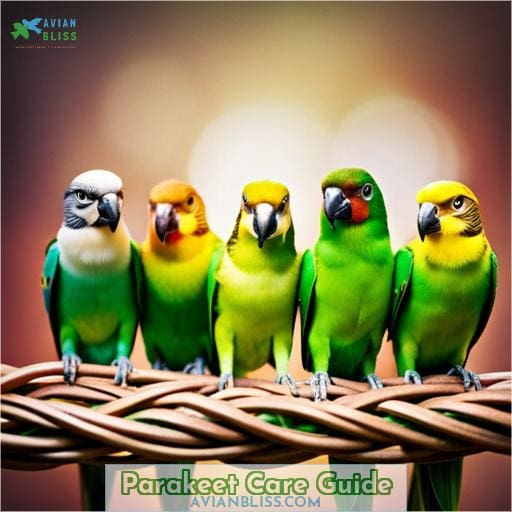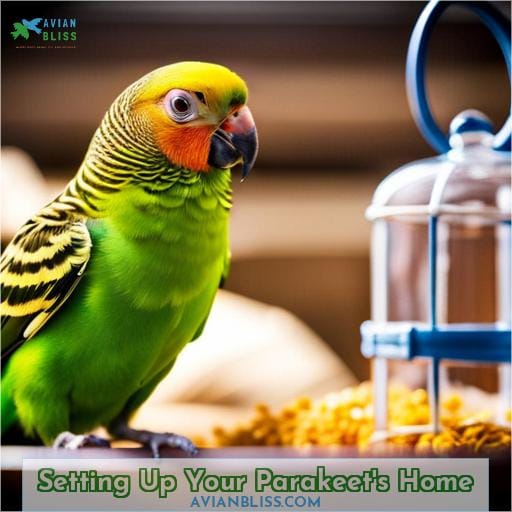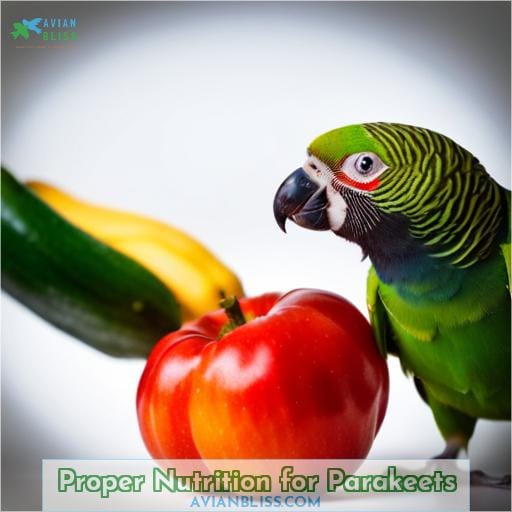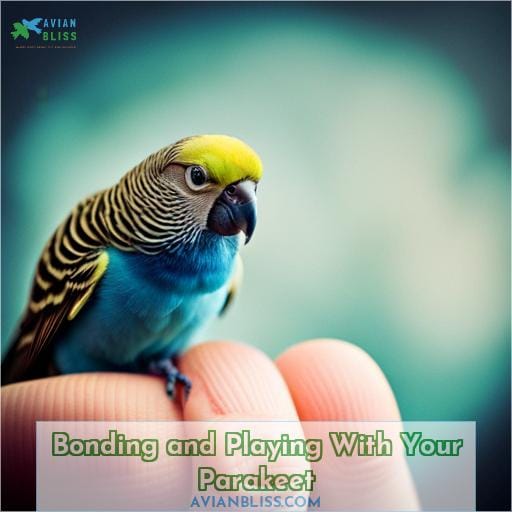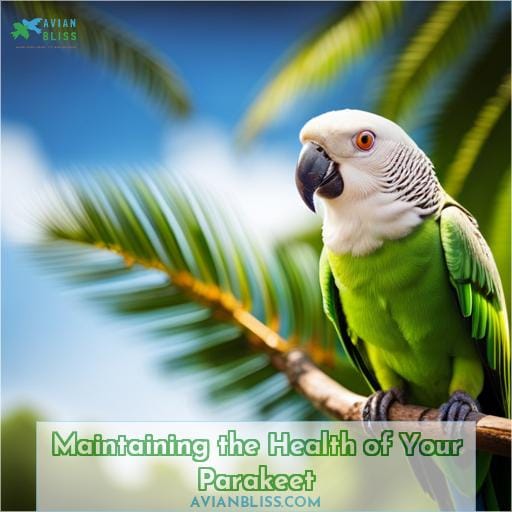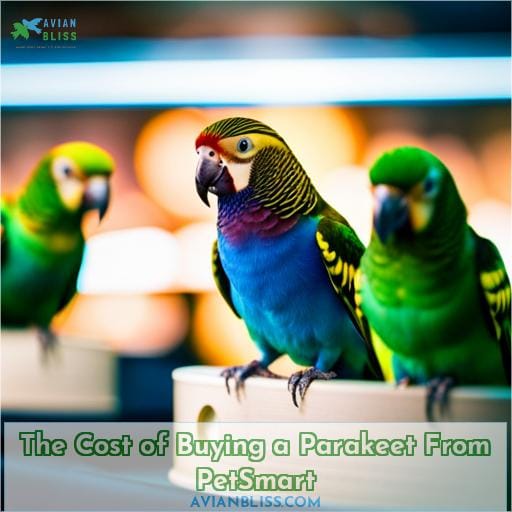This site is supported by our readers. We may earn a commission, at no cost to you, if you purchase through links.
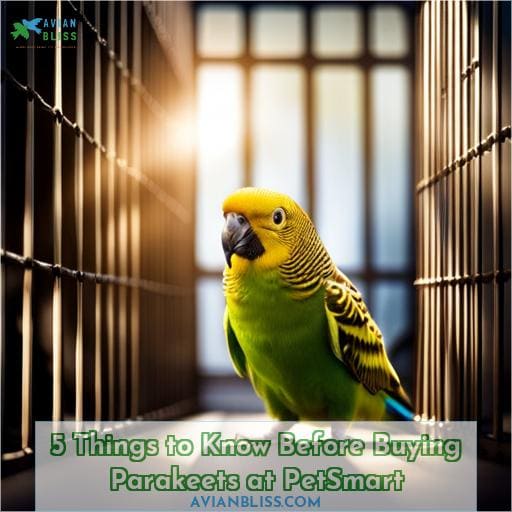 Before you bring home a new feathered friend, there are five important things to know about buying parakeets at PetSmart.
Before you bring home a new feathered friend, there are five important things to know about buying parakeets at PetSmart.
From understanding proper care and nutrition to creating a comfortable environment for your pet, this guide will provide you with the essential knowledge to ensure the health and happiness of your new companion.
Discover what sets PetSmart apart in terms of quality assurance and learn about the different types of parakeets available at our stores.
Get ready for an exciting journey into bird ownership!
Table Of Contents
- Key Takeaways
- Parakeet Care Guide
- Setting Up Your Parakeet’s Home
- Proper Nutrition for Parakeets
- Bonding and Playing With Your Parakeet
- Maintaining the Health of Your Parakeet
- Things to Consider Before Buying a Parakeet
- The Types of Parakeets Available at PetSmart
- The Cost of Buying a Parakeet From PetSmart
- Tips for Shopping at PetSmart for Parakeet Supplies
- Preparing Your Home for a New Parakeet
- Frequently Asked Questions (FAQs)
- What is the average cost of a parakeet at PetSmart?
- How often should I take my parakeet to the vet for check-ups?
- Can parakeets be trained to do tricks?
- What are some common behavioral issues in parakeets and how can I address them?
- Are there any specific precautions I should take to keep my parakeet safe and healthy?
- Conclusion
Key Takeaways
- Proper care and nutrition are essential for keeping parakeets healthy and happy.
- Setting up a proper home for your parakeet is crucial, including the right cage size, perches, and bedding.
- Providing a balanced diet with a variety of fruits, vegetables, pellets, and seeds is important for their nutrition.
- Spending quality time bonding and playing with your parakeet is necessary for their socialization and mental stimulation.
Parakeet Care Guide
Taking care of your parakeet involves providing them with:
- Proper nutrition
- A comfortable living environment
- Plenty of opportunities for socialization and play
When it comes to cage size, the minimum recommended dimensions are 18 x 18 x 24 inches.
- Line the floor with recycled-paper bedding or use a paper liner that should be replaced at least every other day.
- Place the cage away from drafty windows and doors, at or below eye level.
In terms of food, include:
- Pelleted food as around 15-25% of their diet
- A bird seed blend making up approximately 50-60%
- Fresh vegetables like dark leafy greens every other day
- Fruits such as berries or melons can also be given regularly.
Don’t forget about toys! Parakeets love to interact and entertain themselves inside their cages so provide them with various toys for mental stimulation.
Setting Up Your Parakeet’s Home
Now that you have a parakeet, how can you set up its home to ensure it feels safe and comfortable? Here are three important factors to consider:
- Cage Size: Make sure the cage is large enough for your parakeet to move around freely. The minimum recommended size is 18 x 18 x 24 inches.
- Food and Water Bowls: Provide separate bowls for food and water inside the cage. Opt for sturdy, easy-to-clean bowls that attach securely to prevent spills.
- Perches and Toys: Place multiple perches at different heights in the cage so your parakeet can exercise its feet muscles comfortably. Additionally, include a variety of toys like bells, swings, and chewable items to keep your bird mentally stimulated.
Remember that the location of the birdcage also plays an important role in ensuring your pet’s well-being.
Proper Nutrition for Parakeets
To ensure the health and well-being of your new parakeet, it’s important to provide them with proper nutrition on a regular basis.
Parakeets have specific dietary needs that must be met in order for them to thrive.
-Pelleted food
-Seed blend
-Fresh vegetables
-Fresh fruits
Pelleted food should make up 15-25% of their diet while bird seed blend should comprise about 50-60%. Fresh vegetables such as dark leafy greens should be offered every other day along with small portions of fresh fruits like berries or melons.
Treats like honey sticks or millet spray can be given once monthly as an occasional indulgence.
In addition to providing proper nutrition through their diet, parakeets also require bathing and preening activities which are essential for maintaining healthy feathers and skin condition.
Not only does good nutrition promote overall physical health in parakeets but it also plays a role in preventing certain health problems such as obesity or malnutrition-related diseases that can lead to behavioral issues if left unaddressed.
By ensuring that you meet your pet’s nutritional needs from the start by offering quality food options available at PetSmart supplemented with treats when appropriate (all within moderation), you’ll set yourself up not just financially but emotionally too because now they won’t develop any potential future complications due solely because there wasn’t enough variety present during those early stages – remember: prevention beats cure!
Bonding and Playing With Your Parakeet
To bond and play with your parakeet, spend quality time interacting with them daily.
- Hand feeding: Offer treats or small pieces of food from your hand to build trust.
- Training and tricks: Parakeets are intelligent creatures that can be trained to perform various tricks like stepping up onto your finger or even talking!
- Singing and whistling: Parakeets love music, so sing along or whistle tunes for them. They may even mimic you!
- Talking and mimicking: Teach your parakeet simple words or phrases by repeating them consistently. Soon enough, they might start talking back.
By engaging in these activities regularly, you not only provide mental stimulation but also strengthen the bond between you and your companion.
Maintaining the Health of Your Parakeet
To maintain the health of your parakeet, you should provide regular veterinary care and monitor their overall well-being.
Common health problems in parakeets include respiratory infections, feather plucking, and digestive issues.
- Sneezing or discharge around the nose or mouth
- Sitting on the bottom of the cage for long periods of time
- Feathers being fl■ up excessively during the day
If you notice any signs of illness in your bird, it’s important to seek treatment from a veterinarian who specializes in avian care.
Preventing illness and injury can be achieved by:
- Providing a clean environment with fresh food and water daily
- Avoiding toxic household substances that could harm them if ingested or exposed to fumes
- Ensuring they’ve plenty of mental stimulation through toys and social interaction with humans or other birds when appropriate.
Things to Consider Before Buying a Parakeet
Before buying a parakeet, there are several important things to consider.
Firstly, it’s essential to understand the potential health risks associated with purchasing a bird from PetSmart or any pet store.
Additionally, ethical concerns regarding the sourcing of birds from mills should be taken into account.
Finally, exploring alternatives such as adopting a bird from a rescue or re-home situation may be worth considering as well.
Health risks associated?
Before buying a Parakeet at PetSmart, it’s important to consider the potential health risks associated with owning these birds.
Some of the health risks include:
- Salmonella and Psittacosis: These are bacterial infections that can be transmitted from birds to humans.
- Respiratory Infections: Parakeets are susceptible to respiratory infections that can cause difficulty breathing and other respiratory issues.
- Beak and Feather Disease: This viral disease affects the feathers, beak, and immune system of parakeets.
- Behavioral Issues: Parakeets may exhibit feather plucking, self-mutilation, aggression, biting or loud vocalizations due to stress or boredom.
Ethical concerns regarding?
Consider the ethical implications of buying a parakeet from PetSmart.
Birds aren’t commodities, they’re sentient beings that deserve good homes and proper care.
It’s important to remember that birds aren’t toys or disposable pets.
Before purchasing a parakeet, think about the responsibility involved in providing for their physical and emotional needs throughout their lifespan.
Consider adopting from a rescue or re-home situation to give these deserving creatures a second chance at happiness.
Alternatives to buying?
If you’re thinking about bringing a parakeet into your home, there are alternative options to consider before making a purchase from PetSmart.
Instead of buying from pet stores or breeders, you can choose to adopt a parakeet from rescues, shelters, or organizations that specialize in bird rescue and rehoming.
These sanctuaries and rescues often have parakeets available for adoption and can provide valuable information on caring for these birds.
Fostering is another option where you temporarily care for a parakeet until they find their forever home.
The Types of Parakeets Available at PetSmart
Now that you’ve considered all the important factors before buying a parakeet, let’s dive into the exciting world of the types of parakeets available at PetSmart. These colorful creatures come in various breeds, each with its own unique personality and trainability.
When it comes to lifespan, parakeets typically live between 7 to 10 years with proper care. As for cage size, it’s essential to provide them with a minimum space of 18 x 18 x 24 inches for their comfort and well-being.
In terms of diet, your feathered friend will thrive on a combination of pelleted food (15-25%), bird seed blend (50-60%), fresh vegetables like dark leafy greens every other day), and fruits such as berries or melons every other day as well.
To keep your parakeet healthy and happy inside their cage while you’re away or busy elsewhere; providing toys for entertainment is crucial! These toys help stimulate their minds and prevent boredom during long periods alone in captivity.
The Cost of Buying a Parakeet From PetSmart
When purchasing a parakeet from PetSmart, you can expect to pay an average price range of $20 to $40. However, keep in mind that this is just the initial cost of buying the bird itself. There are additional expenses associated with owning a parakeet that you should be aware of.
The cost of a suitable cage for your parakeet can range from $50 to $100 depending on size and quality.
You’ll also need to budget for food, which typically costs around $10 to 20 per month, as well as toys and enrichment items which can add another $10 to 20 per month.
It’s important not forget about regular vet visits for your feathered friend, which could set you back anywhere between$50 and$100 per year.
These ongoing costs should be considered before making the decisionto bring homea petparakeetatPetSmart
Tips for Shopping at PetSmart for Parakeet Supplies
When shopping at PetSmart for parakeet supplies, make sure to choose items that are specifically designed for the needs of your feathered friend.
-
Cage size:
Ensure that the cage you purchase is spacious enough for your parakeet to move around comfortably. A minimum cage size of 18 x 18 x 24 inches is recommended.
-
Food and water bowls:
Look for bowls that can be securely attached to the cage and are easy to clean. It’s important to provide fresh food and water daily.
-
Toys, perches, and mirrors:
Parakeets love toys that they can interact with, such as bells or swings. Natural wood toys are a good choice as they’re safe for birds and durable. Avoid small parts on toys or mirrors that could pose a choking hazard.
By selecting appropriate supplies like these, you’ll ensure a safe and enjoyable environment for your beloved pet parakeet from PetSmart!
Preparing Your Home for a New Parakeet
To ensure a smooth transition for your new feathered friend, it’s essential to prepare your home with the necessary supplies and a safe environment.
Start by choosing an appropriate cage size for your parakeet. The minimum recommended size is 18 x 18 x 24 inches, providing enough space for them to move around comfortably. Set up food and water bowls within easy reach of the bird’s perches, making sure they’re securely attached to prevent spills or accidents.
Next, provide plenty of toys to keep your parakeet entertained and stimulated. Opt for toys made specifically for small birds like parakeets, ensuring they’re safe and free from any potential hazards such as small parts that could be swallowed.
Don’t forget about perches! Place multiple perches at varying heights in the cage so that your parakeet can exercise their feet muscles while also having different vantage points throughout their habitat.
Lastly, choose a suitable location in your home where you’ll place the birdcage. Avoid drafty windows or doors as well as areas with excessive noise or temperature fluctuations (such as near air conditioning vents).
Remember that social animals like parakeets thrive on interaction – consider placing their cage in an area where family members spend most of their time.
Frequently Asked Questions (FAQs)
What is the average cost of a parakeet at PetSmart?
At PetSmart, the average cost of a parakeet is around $20 to $ However, prices may vary depending on factors such as breed and location. It’s always best to check with your local PetSmart store for specific pricing information.
How often should I take my parakeet to the vet for check-ups?
To ensure the health and well-being of your parakeet, it’s recommended to schedule regular check-ups with a veterinarian.
A yearly visit should suffice, but if any concerning signs arise, don’t hesitate to seek professional advice.
Can parakeets be trained to do tricks?
Parakeets are highly trainable and can learn a variety of tricks, such as:
- Stepping up on your finger
- Even playing basketball!
With patience, positive reinforcement, and consistency in training sessions, you can have fun teaching your parakeet some impressive skills!
What are some common behavioral issues in parakeets and how can I address them?
Address common behavioral issues in parakeets to ensure a happy and well-adjusted pet.
Did you know that excessive biting is the most common issue? To address it, provide appropriate toys, socialization, and positive reinforcement training techniques.
Are there any specific precautions I should take to keep my parakeet safe and healthy?
To keep your parakeet safe and healthy, make sure to provide:
- A suitable cage with proper dimensions and bedding.
- Place the cage away from drafts, out of the kitchen, and at or below eye level.
- A balanced diet of pellets, seeds, fresh vegetables, fruits as treats.
- Change water daily.
- Toys for mental stimulation and social interaction with you.
- Monitor their behavior closely for any signs of illness or distress and consult an avian veterinarian if needed.
Conclusion
To ensure the health and happiness of your new feathered friend, it’s crucial to know five important things before buying parakeets at PetSmart.
From understanding proper care and nutrition to creating a comfortable environment, this guide equips you with the essential knowledge.
PetSmart stands out in terms of quality assurance, offering various types of parakeets.
Remember to consider health risks, ethical concerns, and alternatives before making a purchase.
With the right information and preparation, you can embark on an exciting journey into bird ownership.

